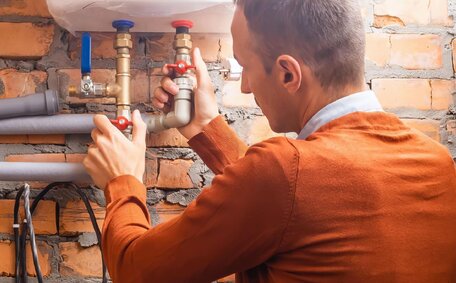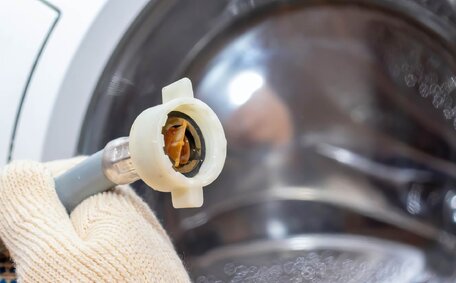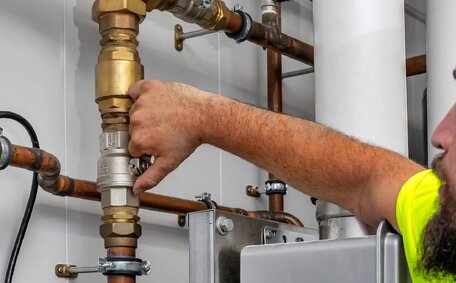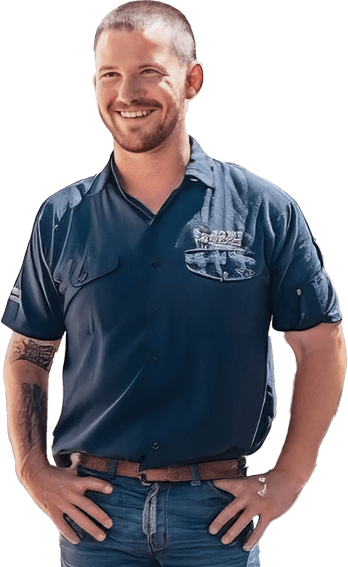Introduction to Hot Water System Efficiency
Hot water heating consumes a substantial part of home energy use, emphasising the need for energy efficiency. Homeowners can adopt methods to enhance their hot water system efficiency, reducing costs while maintaining performance.
This article guides you through optimising your hot water system, covering heat traps, thermostat settings, and energy-efficient upgrades.
Saint Marys Plumbing expertly maintains and repairs your hot water system, ensuring efficiency and safety with our skilled licensed plumbers.
Checking Current Efficiency Levels
Check your hot water system’s efficiency by reviewing your energy bills and consulting a local licensed plumber if needed. Seasonal spikes in energy bills may indicate reduced hot water efficiency due to your system’s strain or failure to deliver enough heated water.
An underperforming hot water heater typically signals the need for system maintenance. Insufficient hot water output suggests a restricted flow, necessitating a system tune-up.
Inspect your hot water system’s insulation. Ensure the water tank insulation is complete, with no gaps or tears. Adequate insulation helps minimise standby heat losses and improve efficiency.
Consider installing a digital thermostat, which allows for accurate temperature control of your electric water heater compared to traditional analogue models. Optimal temperatures help your electric hot water heater operate efficiently, preventing energy waste and bacteria growth.
To reduce waste, run a hot tap for a set period into a bucket and measure to confirm the output matches expected usage. Collecting more than 20 litres indicates overuse, suggesting potential upgrades like flow restrictors to reduce excess.
Adjusting Thermostat Settings
Adjusting the control valve of your hot water system is crucial for efficient and safe heating of water. Follow these steps to access the controls:
- Find the access panel on your hot water system, typically located near the top or bottom of the unit.
- Remove the panel cover to locate the thermostat dial, or adjust the gas control knob to your preferred setting.
- Use a thermometer to check the hot water temperature inside the storage water heater is optimal so your system can maintain prescribed heat levels. Insert the probe through the provided port on the side of the tank.
- Turn the thermostat knob slowly to adjust. To mitigate safety risks, ensure the temperature is set higher than the minimum of 60°C to prevent Legionella bacteria proliferation.
- Reset your tank storage temperature to 60-65°C for optimal efficiency, avoiding excess energy in heating water.
- Replace the access panel once adjustments are complete.
Should you face difficulty with controls or adjustments, don’t hesitate to contact Saint Marys Plumbing. Our seasoned experts can inspect your system and when necessary, call plumber professionals to properly calibrate thermostat settings and enhance efficiency.
Improving Insulation
Improving insulation is a practical approach to increase efficiency in your gas water system. This approach reduces standby heat losses from the gas storage tank and its piping.
For the tank itself, ensure insulation wraps fully around with no gaps. Damaged or missing sections should be repaired or replaced. Aim for an R-value of at least R24 to optimise heat retention.
Insulating hot water system pipes at your residence ensures the return water remains at optimal temperatures, reducing heat losses by 25-45%. For easiest access within your house, insulate pipes leading to your electric hot water systems in unconditioned spaces like attics or basements first. Pre-slit foam tubing can be wrapped around pipes fairly simply.
Proper insulation can save upwards of 500kWh annually for gas systems, aiding substantial energy conservation. Ensuring both your gas and electric hot water heaters operate efficiently can curb unnecessary energy use.
Our team of plumbers at Saint Marys Plumbing can inspect the insulation of the hot water system in your home and recommend custom improvements to maximise efficiency savings.
Installing Energy-Efficient Fixtures
Water-efficient fixtures reduce hot water demand and can lower your energy bill. Swapping out showers, taps, and other fixtures with these low flow alternatives can make a substantial difference in reducing water flow rates.
Water-efficient shower heads restrict flow to under 9.5 litres per minute, compared to traditional models’ 15-25 litres output. Installing a 3 star WELS rated shower head can save approximately 35,000 litres of water per year.
When selecting new fixtures, look for WELS ratings of at least 3 stars for taps and 4 stars or higher for shower heads. The higher the rating, the more water-efficient the fixture, making them the most common choice for eco-conscious homeowners.
Other efficient fixture enhancements, which are things you can do to cut down costs, include different types of hot water aerators:
- Aerated taps and shower heads - air injection reduces flow while maintaining wetness
- Thermostatic mixing control valves - help prevent scalding by maintaining stable temperatures
- Low-flow toilets with 4 star rating or higher - reduce flush water usage
Saint Marys Plumbing can recommend suitably rated water fixtures to boost your home’s efficiency during any plumbing project.
Flushing the System
Over time, sediment and mineral deposits can cause a build-up inside hot water systems. This limescale buildup coats the inside of tanks and pipes, reducing heat transfer efficiency. It also clogs valves and fittings, restricting water flow in storage water heaters.
For optimal gas heater performance, it’s advisable to flush the system annually to maintain its integrity. This helps clear out sediment so your system achieves energy saving performance, running cleanly and efficiently.
Refer to the section below on how to check and execute a proper system flush:
- For safety, turn off the circuit breaker or gas line before maintenance and close the cold water inlet valve.
- Connect garden hose to drain valve near bottom of tank.
- Route hose to exterior drain area. Open valve to release pressure if there’s no water initially, then proceed when the flow starts.
- Once water coming out hot from the tank starts flowing, allow it to fully drain. This removes loose sediment.
- Close drain valve once water runs clear. Disconnect and store hose.
- Open cold water inlet valve to refill tank. Check for leaks during this process.
- After a power outage, ensure there’s power by checking the safety switch or pressing the reset button once the tank is full. Monitor temperature gauge to ensure proper heating.
Carefully flushing your system and seeking professional advice if necessary is a prudent course of action. Should hot water issues persist and it’s time to call in experts, Saint Marys Plumbing is here to offer professional draining and flushing services.
Upgrading to a New System
Upgrading to new energy-efficient hot water systems is a strategic move for significant long-term energy savings at home. Modern systems like heat pump water heaters or solar models can bring substantial savings on water heating bills by reducing them by an estimated 50-65%.
While upfront costs of upgrades may seem high, most will pay for themselves within 5-7 years through energy savings. There are also rebates and incentives available in many areas to improve affordability.
Key benefits of upgrading include:
- Lower energy bills - Cut water heating costs significantly for those who need hot water regularly through improved efficiency
- Better performance - Enjoy continuous flow of hot water and stable water pressures
- Added value - Increase your home’s resale value by upgrading systems
- Reduced carbon footprint - Decrease environmental impact through renewable energy models
Our team at Saint Marys Plumbing specialise in hot water system upgrades, including relief valve installations, helping you get your hot water tank serviced to relight pilot lights as necessary. We tailor solutions to suit your home’s specific needs while ensuring a stable pilot flame and maximising energy and cost savings.
Reach out to us for guidance on upgrading your system and piloting an efficient new model, also capitalising on available rebates.
Maintaining Safe Temperatures
Ensuring safe temperatures in hot water systems is crucial to prevent Legionella bacteria from flourishing. Legionella proliferates between 20-45C, so hot water should be stored at 60C or higher.
To maintain safe temperatures:
- Set thermostat to 60-65C - High enough to prevent bacteria growth but avoid wasting excess energy and keep your bills lower
- Insulate pipes and fittings - Prevents heat loss so water stays hot in transit
- Flush systems annually - Removes sediment buildup so water can be heated efficiently
- Install thermostatic mixing valves - Mix hot water with cold to safely deliver tempered water to fixtures
By following these guidelines, homeowners with a gas hot water system can ensure water is both efficient and safe, inhibiting hazardous Legionella bacteria growth.
For guidelines on balancing efficiency and safety in your hot water system, please see the section below or contact a licensed plumber at Saint Marys Plumbing. Our licenced plumber can ensure your system operates effectively without posing health risks.
Seeking Professional Assistance
Several indicators signal when professional assistance is necessary for hot water system recalibration:
- If after making thermostat and insulation adjustments you still have no hot water, and note high energy bills or hot water supply issues, it’s time to consult a professional.
- The system makes abnormal noises like banging or steam releasing during operation.
- You notice leaks, rust spots or other visible damage to the water heater exterior.
- Hot water output is extremely low or intermittent, even after attempted DIY troubleshooting which you can do at home.
- The hot water has an unusual odour, colour or cloudy appearance indicating contamination.
Saint Marys Plumbing professionals can expertly diagnose and recalibrate your system for maximum efficiency. We calculate ideal thermostat settings specific to your usage patterns, ensuring precautionary measures against Legionella.
Upgrades can also be recommended if your existing system is outdated or replacement is the best option. As leaders in plumbing services, we make sure health and safety remains the top priority while maximising energy savings.
For expert guidance on how to check relight pilot lights for efficiency enhancements in your system, reach out to our professional plumbers. Our experience with all major hot water system brands and fuel types equips us to enhance performance in your home.






